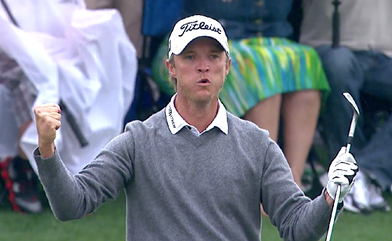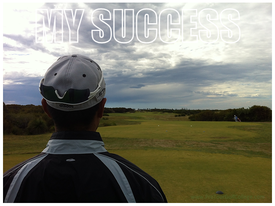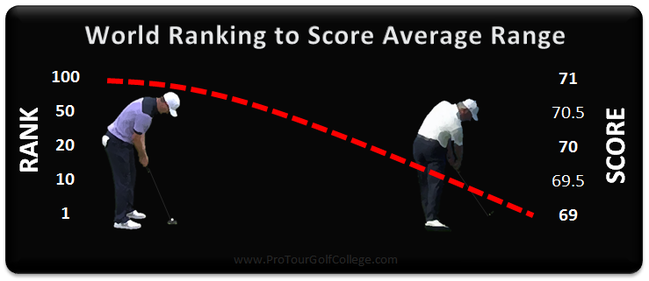|
There are millions of average golfers who play regularly around the world, and there are also thousands of elite golfers - both amateur and professional who compete regularly in tournaments. Of the thousands of elite golfers who compete in tournaments, just a fraction of them will crack the top 100 in the world rankings. Take Anirban Lahiri for example. Anirban is from India and has played on the Asian Tour for 7 years (2008 – 2014) and at the time of writing has played in 117 tournaments and has won 10 times in India , and also has 5 victories on the Asian Tour with 2 victories this year. On the face of it Anirban has played more than 380 competitive rounds on the Asian Tour and in April 2014 his victory at the Indonesian Masters finally broke him into the top 100 in the world. I’m sure you’ll agree that cracking the top 100 in professional golf doesn’t come easily. So what can we learn from Anirban’s example, and what playing standard is required to achieve this status? The first thing that comes to mind is that it takes time, a lot of time, and a lot of effort, over many rounds, to achieve it. Every golfer who cracks the top 100 has invested thousands of hours of dedication to achieve this exalted status. Secondly the golfers in the top 100 come from many different countries around the world, and every golfer in the top 100 has a unique style of playing golf, and generating results on the golf course in tournaments. You will also see 100 different styles of golf swing, and 100 different body types that vary from tall and thin to short and stocky, and everything in between. The bottom line is that no two golfers in the top 100 swing it the same way, or play the same way. And yet there is a common denominator? There is something that we can say about them that is relatively consistent about the way they play?  The 3 Shot Success Window All these golfers will produce a score average (actual) between 69 and 71 over a season regardless of which tour they play on. That is, they will produce a score average within this 3 shot range against par, in rain, hail or shine. I have trawled through the statistics of the top professional players on most of the major men’s and women’s tours over the years and this 3 shot window is the one thing always stands out. This is the performance window that you need to aim for, and everything you do in your game development should ultimately lead you into this space if you desire to become one of these elite 100 performers. Scoring within this 3 shot performance window over the course of a season will do 2 important things for you that will ensure your success playing on a professional tour.
In Anirban Lahiri’s case he has averaged 66.6 percent of cuts made over 7 seasons on the Asian Tour, and has amassed earnings of more than 1.6 million dollars so far. We can’t stress enough the importance of scoring in this range on a consistent basis. Think about it, whether you are competing at a tour school, or you are competing on a tour, the simple fact is that you will have to score in this range often to make cuts and get paid. This is the reality of professional golf, and the most successful golfers - those who have the lowest score average over a season tend to make a higher percentage of cuts on average.  7 Years and 6,858 Holes... Over 7 years and 381 competitive rounds, (or 6,858 holes played to date), Anirban has averaged 70.98, and this stands as testament to his skill at producing rounds low enough to make more cuts than he misses, and to make more money than he spends. A score average like this, (or better) over enough seasons will catapult you into the top echelon of golfers regardless of where you currently play. If you are playing on a minor tour at the moment and you can play to this standard over a season, then it is only a matter of time before you will step up to the major leagues. And if you can’t just yet, then the formula we will share with you below, will help you to get your thinking in the right place to develop your game to a top 100 standard. Here’s the thing you need to know and remember; lowering your competitive score average should be your big goal if you want to mix it with the top tier golfers. Remember the following formula the next time you go out to practice, or the next time you sit down to write out your goals. Whatever you do, you must make absolutely sure that you continually work on the factors (inputs) that drive your scores down (outcomes) in tournaments. At Pro Tour Golf College we take pride in searching outside the box for the best strategies for improving golf performance, and we haven’t found a better approach than the Six Sigma approach. Building a Reliable Golf Success Bridge - The Six Sigma Golf Improvement Process To develop a competitive score average within the 3 shot window you need to look carefully at the building process you use to develop your game. Last week we shared the B.R.I.D.G.E acrostic with you. Build Reliable Intuitive Dependable Golf Experiences The Six Sigma process is a set of techniques and tools developed originally for process development in manufacturing. It was originally conceived and developed by the Motorola Corporation in 1986 and non other than the former CEO of General Electric Jack Welch made it central to G.E business strategy and practice in the mid 90's. Today the Six Sigma process is used in many industrial and business sectors. The goal of Six Sigma is to improve the quality of a process and its output(s) by identifying and removing the causes of defects or errors, and minimizing variability in manufacturing and business processes. Think manufacturing golf shots (short or long) under pressure. (Source: http://en.wikipedia.org/wiki/Six_Sigma) When I came across this approach to process improvement in the mid 90’s I thought there was no reason why some of the principles that guide the Six Sigma process to improvement couldn't be applied to training elite golfers more effectively. The Breakthrough Equation The Six Sigma approach to improvement can be summed up with “the breakthrough equation.” This is an extremely helpful and useful equation that will help any serious golfer or instructor to construct an effective golf improvement framework and process (B.R.I.D.G.E) aimed at lowering a competitive score average or in-fact to improve any development process. The Six Sigma Breakthrough Equation Y = f(X) + ε
In other words... "Your Targeted Score Average (Outcome) = The Quality of the Improvement Elements you Introduce (Inputs) and Order That You Introduce Them into Your Improvement Process (Function) Plus Minimization and Stabilization of Error Potential." Source: http://www.dummies.com/how-to/content/how-to-use-six-sigmas-breakthrough-equation-y-fx-a.html  The Six Sigma Breakthrough Equation will help you design an improvement process that takes into consideration the variables that can (and will) affect the outcomes you are aiming at. It will help you gain clarity around how you improve your skills to improve your score average, and it will help you decide on the most effective change strategies. To build a reliable golf success bridge that takes you from where you are currently to where you wish to go requires a quality improvement process, if you want to get the most from your game. You need to identify the critical few factors that would influence a lower score average the most. Right now could you identify where the errors come from in your game and what causes them? Get to work with your instructor today identifying them, and then go to work improving them, so you can reduce your error rate, and ultimately lower your score average in tournaments into the magical 3 shot window. See you next week with part 4, Cracking the golf success code. Lawrie Montague and David Milne - Pro Tour Golf College Your Success On Tour is Our Business
1 Comment
How to Become a World Class Golfer: Before You Begin You Must Know This Important Rule (Part 2)23/10/2014  Last week we discussed the importance of developing the idea of becoming a world class golfer into a vision statement where you describe as clearly as you can where you would like your game to be in 5 to 10 years. But realistically what are the odds of you becoming a world class professional golfer? Well, on the face of it, not very good. If you look at all the male and female professional golfers competing on professional golf tours around the world and you took their average income earned over a season, very few professional golfers earn more than 50,000 dollars or its equivalent in a season. On top of this, most will give up on their dream within 3 to 5 years of starting out because they find the daily grind of travelling, competing, and for the most part falling well short of their performance expectations (missing too many cuts and earning a meager income) soul destroying. However there are some professional golfers who refuse to give up and keep turning up to play no matter how tough it is. They keep finding big enough reasons to keep competing even when down to their last dollar. They are driven by their dream that one day they will play the way they truly want, become a top ranked golfer, and win a big tournament, and gain fame and fortune playing big time golf. I’m sure you can appreciate that the most successful golfers are those that keep moving forwards, continually finding ways to improve their game and become more competitive in tournaments?  There is the argument that they have more talent than the next guy or gal, but is debatable, because many of the golfers who have risen to the top of golf’s totem pole throughout history were often considered lesser golfers by the “experts,” and far from talented golfers. Aren't we lucky that these tough golfers refused to listen to the naysayers and knockers? Having worked with many tour players and elite amateur golfers over the years we have noticed that one of the biggest stumbling blocks for many serious golfers is not that they don’t know how to play the shots, or that they don’t have the ability to become a top class golfer. What we have noticed is that those amateurs and professionals that keep playing and improving their game definitely have a better way of managing the struggle. What is the struggle? The struggle is those frustrating and annoying golf days where it seems like whatever you do it is a long way from your expectations, and you feel like you want to give up the fight, you want to stop trying to manage your score, but you know that you can’t. Have you heard the saying “it’s not the dog in the fight; it’s the fight in the dog?” Do you have a high tolerance for misfortune and adversity? You better if you want to become a top 100 golfer. The real skill to becoming a world class golfer is the ability to keep upgrading your golf skills to make it easier to manage the struggle, and as simple as this sounds, believe me it is the biggest challenge you will face. Let me say it again; the real skill is upgrading your golf skills to manage the struggle. Manage the struggle and you manage the score.  We describe the struggle with the 25/75 rule for 4 round tournaments. Basically the 25/75 rule states that just 1 round out of 4 (25%) will be much closer to your expectations, and that 3 rounds out of 4 (75%) will be a long way from your expectations, and it will be a struggle to score well. Therefore the idea behind this rule is to know and accept this as being a normal part of top level golf. What kind of mind-set would you need to develop if you accept the 25/75 rule as normal? What elements of your game would you develop knowing that 3 rounds out of 4 could very likely be a struggle to score well? Interestingly we find that many of the elite golfers who struggle with their game on a continual basis can and often do see this rule the other way around. They see golf as a 75/25 game with 75 percent of their golf played close to their expectations, and 25 percent that is not close to their expectations. What kind of mind-set would this golfer develop? Think about this for a moment because it is very important. This in our opinion is the difference between striving for excellence verses striving for perfection. There is no room in top level golf for perfectionists (sorry), but there is plenty of room for excellence—where excellence describes the attitude of continually striving to improve, and perfection is a golfer continually striving to be perfect, or to play perfectly—without mistakes.  Matt Jones reacting favorably to a holed pitch to win on the PGA Tour Matt Jones reacting favorably to a holed pitch to win on the PGA Tour Golf is a scoring game built around reducing mistakes (not avoiding them) by constantly managing your emotional content. It seems to me that if you can develop the knowledge of how to do this, and improve the mental skills that will hold you back from making progress – before you start out on your journey towards becoming a top class golfer, it would make a lot of sense. So what does the research tell us about world class individuals? What is the personality profile of a world class athlete? (Pay close attention to this) Well according to an analysis of the research literature by William P. Morgan, University of Wisconsin-Madison emeritus professor and renowned sports psychologist, the psychological profiles of elite athletes are superior to those found for lower classification athletes as well as the general population. In terms of psychological states, world class athletes scored low in; a) Tension b) Depression c) Anger d) Fatigue e) Confusion On the other hand they scored extremely high in; a) Self-confidence b) Mental toughness c) Determination. This psychological profile was found to be noticeably different to the profiles found for non-elite athletes and also the normal population. Remarkably, it was also discovered that non-elite athletes have almost the same psychological profile as the general population. They were inclined to experience a higher level of anxiety, confusion, depression, fatigue and anger than their elite colleagues, and they also showed significantly less confidence, mental toughness and determination. Source: http://strengthplanet.com/other/15-surprising-facts-about-world-class-athletes.htm At Pro Tour Golf College our students are constantly educated to understand these performance limitations well before they make the move to qualify for a professional golf tour. We want them to build a sturdy golf success bridge, and before you start constructing your bridge you need to know the possible challenges along the way. This is an important part of your preparation, and when you think about it, can you think of anything worthwhile and enduring (like a bridge) that was constructed without a comprehensive knowledge of all the things that could go wrong?
Well it is no different building your golf success bridge. When you think about building your bridge you will find it helpful to use the B.R.I.D.G.E acrostic. Build Relevant Intuitive Dependable Golf Experiences Because golf is a game of constant highs and lows you need a way of managing it so you can keep on top of your ability to manage your scoring ability during your round. In next week’s article (part 3 of our series) we’ll show you how to build your B.R.I.D.G.E with relevant, intuitive and dependable golf experiences to help you develop a game that can manage the normal up's and down's of the game so you can take your game all the way to the top. See you then. Lawrie Montague and David Milne - Pro Tour Golf College Your Success On Tour is Our Business How to Become a World Class Golfer: Building Your Golf Success Vision Statement (Part 1)14/10/2014  Aussie Jason Day is a World Class Golfer Aussie Jason Day is a World Class Golfer Imagine that you decided to become a great golfer—a world class golfer. You love playing golf so much that you want to make it your career choice, and you desperately want to be successful playing it. You dream of winning big professional tournaments, you want to earn lots of money, and you want to walk the beautiful green fairways of Augusta National and many of the other famous golf courses where major golf championships are played. You possibly also want to win a major or two. Does that sound much like you? Do you have a big and bold vision of what you want to achieve in golf that is similar to the one I’ve just described? Are you a golfer who is deadly serious about becoming a top ranked professional golfer sometime in your future? We hope that you do. In today’s article (part 1 of a series) we want to help you to develop your vision of what you need to do to develop your game to a world class standard, and over the following weeks we will help you to build your golf success bridge from where you are to where you want to take your game to.  All Success Begins with a Bold Idea What do you want from playing the game of golf? The definition of an idea is "a thought or suggestion as a possible path to action." I'm sure you would agree that everything "man made" began with an idea first? Everything you can see around you was devised by a man or a woman (or a group of men and women) who thought their idea was good enough to put into action, and eventually through a lot of effort it became a reality. This is a simple statement of fact, ideas need action to exist. As such there are just two main types of ideas.
Here's a simple way to think about it. REALITY Ideas into Action Much of your life is a product of your ideas that became reality. Learning to drive a car started with the idea that you wanted to drive a car, which led to driving lessons, then passing a driving test, and eventually earning a drivers license to legally drive a car on the road. Learning to play golf started with the idea that playing golf was something worthwhile doing. The idea led you to go to a golf course (or driving range) to try it out. You either took some lessons formally, with an instructor, or informally, by reading a book, or possibly watching a DVD. Or maybe a family member gave you some tips to start you off. Either way what started out as an idea became a reality.  The Golf Success Vision Statement? Now there are ideas, and then there are big and bold ideas that you can develop a golf success vision statement around. You see, the effort that moves you towards your vision should come after you develop enough clarity around your vision. And only a vision that is truly inspiring can influence you to become motivated enough to sustain the long-term effort required to achieve your vision. You must be truly inspired by a bold vision of what you believe is possible so you can develop the motivation you need to fuel the daily physical effort required to make it come true for you. You cannot be vague and general about your vision, you must be very specific about it, so you will need to continually render your vision with as much detail as you can imagine. The clearer you are about what you want from the game of golf, the easier it will be to build a plan for turning it into reality. A golf success vision statement is a simple declaration about what you want your golf game to look like in the future (usually around 5 to 10 years but can be longer). It is your long-term vision of where you will take your golf game to. The following questions will help you to start formulating your own golf success vision statement.
Never forget that everyone at the top of world golf was once at the bottom. All world class golfers started out as ordinary golfers with a vision that they could be a lot more. Developing your vision helps you to formulate your plan for getting yourself from where you are currently, to where you wish to go. For a more detailed goal setting process to help you to develop your long-term vision. (click here)  Rory Has a Bold Vision That Drives Him Rory Has a Bold Vision That Drives Him Rory McIlroy's Grand Vision Think about it, how do you think Rory McIlroy developed into a great golfer? It wasn't just hard work was it?. He must have originally started with a bold idea that he could become a great golfer from Northern Ireland. He would have thought about this idea everyday as he went to work on it. Because he was continually inspired by his bold vision, he was motivated to apply himself diligently to it. The result of this constant mental and physical attention to the vision was that it moved him closer and closer to it.  Warning: Where There is No Vision... Here’s the rub though, and it's important. The biggest challenge we continually face working with elite golfers struggling to make progress in their game is that very often their vision is anything but clear. In fact, in most cases it isn't written down anywhere. You cannot achieve unprecedented golf success by just "winging it." Winging it can and does lead golfers to try a bit of this, and try a bit of that. In other words they approach golf improvement as a fragmented and jumbled process that guarantees one thing; they are likely to give up well before they reach their vision. Why? If you have an impoverished vision of what’s possible in your golfing future then you are likely to find it difficult to bring it into reality. You will get a reality, but it won’t be the one you really want. Why would any golfer have the motivation to work really hard on their game if they don’t have an inspiring vision of what they want to achieve from playing golf? Think about it like this. Motivation = Motive (vision) x Action (effort) Therefore a fundamental requirement of long-term golf success is consistent action towards worthy goals. Research backs this up by suggesting that persistence of effort and grit is directly related to a golfers passion for achieving their long-term goals. We find that a lack of vision is probably the biggest stumbling block to elite golf success. In summary, the path to golf success begins with a well thought out vision of what you want to achieve from golf. The clearer you can be about the level of success you wish to achieve playing golf, the easier it will be to develop a relevant and purposeful plan of action. Go to work today on your golf success vision statement. Imagine what your life would be like as a top 100 golfer and everything associated with that vision. In next weeks article we'll show you how to start building a world class golfer plan of action that covers the specific steps that will build your bridge from your vision of what's possible to your reality. See you next week. Lawrie Montague and David Milne - Pro Tour Golf College Your Success on Tour is Our Business There are certain patterns in a player’s performance that characterize a lack of self-belief and mental toughness. For instance,
To start this process, ask yourself, are you effectively building your self-belief?  One primary item in Jones’ (Jones et al., 2007) mental toughness questionnaire assessing the sub-component self-belief reads, “Having an unshakeable self-belief as a result of total awareness of how you got to where you are now.” Many athletes I work with and their families say that this will come with experience. What they refer to is the experience of winning. But anyone can achieve this once and chalk it up to luck saying, “I got lucky out there…a few good bounces in the right direction, and some putts dropped.” But real self-belief and long-term success comes from believing you can replicate high performance over and over and knowing your key ingredients that go into creating top performances. How well are you analyzing your experiences right now in ways that build your belief regardless of the outcome? It does not matter how “inexperienced” you may perceive yourself to be, experiences are relative, and the earlier you start to take stock from the events that have lead you to your current status, the faster you will grow and thrive. Do you know your strengths as a player and how to maximize them in your game? Get to know your most successful moments and most challenging ones and explore in depth what you have learnt about yourself. Do you understand what inner arrogance is truly about?  Another primary item in Jones’ 2007 measure assessing mental toughness reads, “Having an inner arrogance that makes you believe that you can achieve anything you set your mind to.” Interestingly, 90% of the athletes who visit me believe that inner arrogance will lead to complacency and feel its better to be overly self-critical, effectively diminishing self-belief. Many players shy away from using or even thinking of the term arrogance. Firstly, inner arrogance is simply a “feeling” of self-confidence and trust in your skills, and it’s got nothing to do with an overt display of cockiness to others. Secondly, complacency comes from the sole assessment of your success in comparison to the competition pack you most closely identify with. Drive and perseverance will be maintained if you look beyond the local crowd, training partner, or teammate for new bench marks of high performance. Get to know the statistics of the best in the business and don't just follow suit of the regionally ranked players you often compete with. Start to create self-oriented standards for preparation and conduct on the course. This will ensure that your self-confidence remains in your control, NOT in the hands of others, and will ensure you don’t get complacent with meeting the standards set by the pack you train and compete with most often. Do you understand that golf is a game of variables?  To truly understand this point means you conduct yourself by the knowledge and awareness of what you have control over and what do you not; before, during, and after a round and thus, fully understand your priorities or primary focus at each step. Mentally tough players focus their energy on what they can control – their attitude, actions in the moment, preparation and reactions to uncontrollables. Many talented players I work with expect to control the results from the first tee, trying to guide and control each shot and avoid errors. This type of approach lacks the attention to detail in the preparation phase before the tournament, leaving too much to chance in terms of being “hot” or “cold” once you reach the first tee. To gain control you must release yourself from trying to control everything in the moment and instead focus greater attention on the finer details of your preparation from your practice habits to your stretch routine. Taking control of your preparation will naturally put you in the drivers seat on the first tee, freeing your mind to play within your A-game potential. Have you asked yourself…What will it take..? Have you asked yourself, what will it take to get to where I want to be? This was the single question that famous sports marketer author Jon Spoelstra would ask his team when assigned to some of the most ambitious assignments in his career. When he was hired to the New Jersey Nets, Spoelstra implemented clever marketing tactics, which contributed to increasing the team's home game attendance from last in the league when he first arrived to best in the NBA. And it all started from asking himself and his team one question, “What will it take to create the change we want to see.” Sometimes it takes radical questions to kick-start the change that is necessary. Dr Jay-Lee Nair http://www.mentalnotesconsulting.sg/ |
Archives
June 2019
|
Proudly Supported By
Copyright © 2011 - 2018 Pro Tour Golf College
Website Managed By Golf Performance Media
All Rights Reserved
Website Managed By Golf Performance Media
All Rights Reserved











 RSS Feed
RSS Feed



